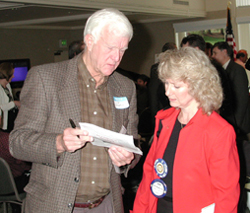|
The Continuing Saga of Hanford Clean-Up
Dr. Jim Trombold, a public health volunteer on the Hanford Advisory Board and a member of Mercer Island Rotary Club, joined the BBRC Friday morning to discuss the situation at the Hanford Nuclear Reservation in central Washington. “My appointment to this Board has taken a lot of volunteer time. Hanford is a huge problem for the area, as well as the nation. We can’t seem to get the attention of Congress for clean-up funding.”
Trombold told of the Tri-Party Agreement between the U.S. Department of Energy, the Environmental Protection Agency and the state Department of Ecology. Added to this trio are the various Indian Tribes who have treaty rights in the area.
Hanford was built in 1943. The U.S. Government — on a war-footing — sought a remote area with abundant water and power. “What they were really looking for was a place to dump waste from this project into the Columbia River. People living in the area were evicted and 50,000 workers were brought in, and within 18 months had built the facility. It was shrouded in secrecy. Its legacy is incredible. There is liquid waste in 177 tanks … 54 million gallons of nuclear waste. One tank is the size of the Capitol Dome in Olympia.”
The doctor went on saying that “the nuclear waste lasts thousand of years. The tanks were built to last for about 40 years. We are beyond that now. It’s a freedom of information problem. A million gallons have leaked into the surrounding area, soil and ground water. The cost of clean-up is a continuing issue. It’s predicted to take 20-30-years – if it ever gets funded.”
This pessimistic report was given with the frustration of a volunteer who wants to do the right thing, but finds the cards stacked against him. Trombold continued: “The Hanford Reach of the Columbia is a beautiful section of this great river. The fact remains that we and the Russians kinda overdid it. We created all this nuclear waste without a solution for its storage or disposal. The Indian tribes don’t want to exercise their treaty rights because of the pollution on the site.”
|

Dr. Trombold talks with Vicky Hunsicker Sanko after Friday’s program.
|
The site produced plutonium for the atom bomb. Production began in 1944. The Nagasaki bomb dropped in 1945 received plutonium produced at Hanford. There are nine reactors and separation plants on the reservation. Production ended in 1990. Hanford covers a 550 square mile area. In the U.S., there are 1500 contaminated sites. There’s an urgency to do the clean-up … the longer the delay, the more problems will arise. There’s a significant threat to workers, people and the environment.
“Most of the storage tanks are single shell tanks. A vitrification facility is being constructed that will separate tank waste and transform it into glass and then re-stored in stainless steel tanks. This transformation won’t occur before 2018. At this time, 200 square miles of ground water has been contaminated at Hanford.”
In addition to the storage of the waste, there are 2000 tons of spent nuclear fuel on the site. Trombold said, “Several tons of plutonium also need to be secured. It’s gonna cost tens of billions of dollars to resolve this issue. And, Hanford is only one of a dozen sites around the country in the same boat.”
A couple of more asides: the Tri-party Agreement was signed in 1989. It was to be a 30-year project, but we’re already halfway home. Hanford’s waste remains a serious threat to the entire Pacific Northwest. Plutonium will take 200,000 years to decay. What’s sobering is that we’ve created this stuff, but we don’t clean up our own mess. Dr. Jim urged all Rotarians to write to the Governor, their Congressman, and Senators and let them know of your concern.
For his presentation, Dr. Trombold was given a certificate showing a book has been made available to a needy child on the Eastside in his name. Thanks to David Miller for his introduction (no relation to Tom Miller, nor to Hubert Mitchell).
|